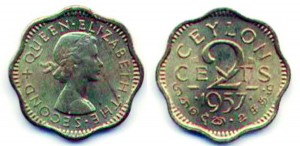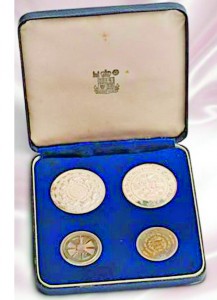UK Royal Mint loses tender to mint coins
View(s):By Kavan Ratnatunga
The Royal Mint in United Kingdom won the contract in 1959 to mint coins for the Central Bank of Sri Lanka (CB) taking over from the Indian Mints in Bombay and Calcutta.
Except for the first Nickel plated steel 50 cent coin of 1996 minted in the Royal Mint in Canada, the Sri Lanka Navy – 50th Anniversary coins minted in Monnaie de Paris in 2000, and the recent Sri Lanka – Japan 60 Years of Diplomatic Relations coin from the Japan Mint in 2012, all other coins were minted at the Royal Mint in UK.

A 1957 2 cent coin
This week on March 11, this strong relationship of over 50 years was broken. The CB awarded contracts to Finland Ltd. of Finland. the Royal Dutch Mint of Netherlands and Mincovna Kremnica of the Slovak Republic for supply of circulation coins of Re.1, Rs.2, Rs.5 and Rs.10 values during the period 2013-2015.
Without awarding the tender to the lowest total contract for minting all the coins, each denomination was considered independently and the lowest bid for that denomination was awarded the contract, leading to three new mints for four denominations.
Cents coins are no longer minted since they are not used now in circulation, although they remain legal tender. The 1 cent coin was last minted in 1994; 2 cent in 1978, 10 cent in 1991.
The 25 cent and 50 cent coins were minted by the CB in 2009 but since they had gone out of circulation by then, finding one with that year is very difficult. The CB claims to have put 5 million of each into circulation, but if that is the case, nearly all seem to have gone immediately out of circulation into some bins at home.
One wonders why at least the cents coins are not demonetized. The last coin to be demonetized was the half cent in 1941. At that time over 70 years ago a gold sovereign was worth Rs10, and now it is worth over Rs 50,000. The half cent coin at the time it was demonetized as value-less was worth Rs 25 of 2013 Sri Lankan Rupees. Thus all of the current circulations coins are worth less than the half cent coin when it was demonetized. So one understands why most of the coins even in plated steel probably cost more than face value to mint.
 The CB which markets high value commemorative coins ignores the need of coin collectors to get regular coin issues.
The CB which markets high value commemorative coins ignores the need of coin collectors to get regular coin issues.
The CB rarely issues year sets and it is not easy to get uncirculated specimens of new circulating coins. If you are interested in collecting a compete set, with every year of issue, even the information of what was issued is not publicly announced in any document or Annual Report, since the Royal Mint stopped doing so in the late 1970s.
I hope the CB will help collectors and announce when it happens the release of these coins from new mints without as they say ‘gradually added to the currency circulation during the period 2013-2015 in order to fulfill the public demand for coins’..
Although newly minted coins are expected to have identical in design to the existing coins collectors can be expected to see slight differences in design.
Among the 175 million Rs 10 coins of this order is a series of 25 coins to be released with motifs of each of the 25 district, along the lines of 50 state quarters issued in USA from 1999 to 2008
The CB says it will also carry out a special coin collection scheme in order to gather the large quantities of currently idle coins, and issue such coins back into circulation. The Cupro-Nickel 25 cent 50 cent and Rs 1 minted before 1996 and Cupro-Nickel Rs 2 and brass Rs 5 coin minted before 2005 have more than the face value in metal. The CB has recycled metal in many of these coins.
A collector friend in Chennai told me recently that he has seen tons of Sri Lankan coins probably smuggled into India to be recycled.
The higher grade coins are put in the collectors market and the rest are melted. No wonder there is a shortage of change and the CB has to mint more coins.
Follow @timesonlinelk
comments powered by Disqus




















